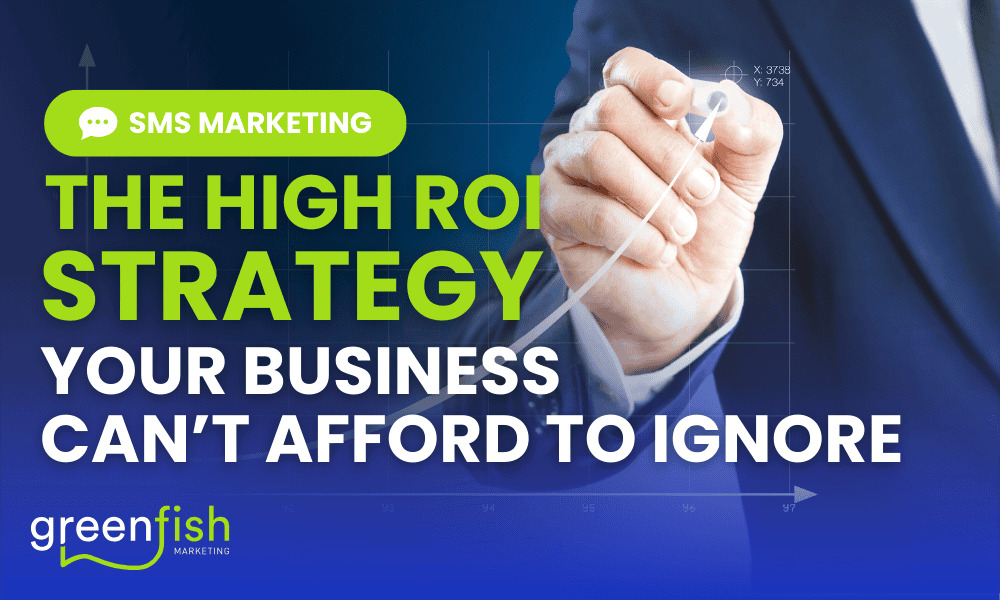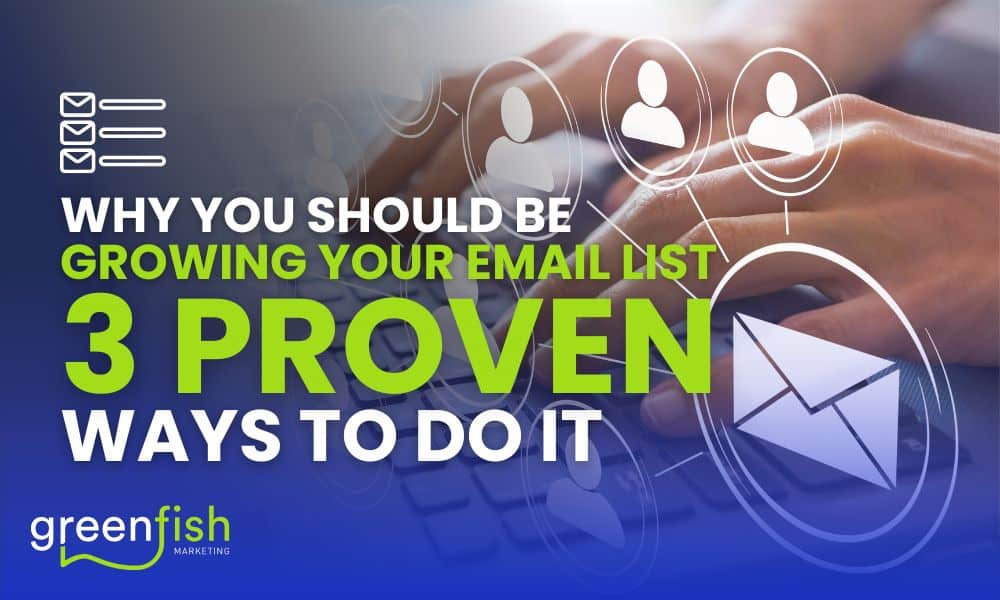It can be irritating to feel like you’re leaving money on the table by not connecting with the customers in your CRM the right way.
You know there’s money in that list, but it can be overwhelming to figure out what to do to reach them and get them to take action.
At Greenfish Marketing, we’ve helped many businesses like yours leverage the power of SMS marketing to boost engagement and sales — we’ve seen firsthand the success that comes with implementing a well-crafted SMS marketing strategy.
In this article, we’ll show you…
- How to integrate SMS with your CRM system
- How to segment your customer list to personalise your messages
- Best practices for creating effective SMS marketing campaigns
With this knowledge, you’ll be one step closer to seizing the opportunity to grow your business with SMS marketing.
The Basics of SMS Marketing
SMS marketing is the practice of using text messaging to communicate with customers and promote your business.
It’s an effective and affordable way to reach your audience directly that can provide a significant return on investment if used correctly.
What is SMS marketing?
In SMS marketing, businesses use text messages to send promotional content, updates, and other information to customers who have opted-in to receive them.
Remember, it is very important to make sure that you have permission to message the people on your list.
Why is SMS marketing important for your business?
Text messages have a remarkably high open rate — up to 98%, vs just 20% for email — meaning your message is almost guaranteed to be seen by your customers.
SMS also has a higher CTR (click-through rate) at 19% compared to email’s 4%.
(20% open rate and 4% click rate are for clients not working with Greenfish Marketing, our results are much better)
SMS marketing also allows you to communicate with customers directly and in real-time — making it great for time-sensitive promotions, updates on new products or services, or even appointment reminders.
Finally, SMS marketing is incredibly cost-effective. Sending a text message is much cheaper than other forms of advertising, such as online advertising, print ads or television commercials.
How does SMS marketing work?
To get started with SMS marketing, you’ll need to choose an SMS marketing platform that integrates with your CRM system, or one with it built in. Once you’ve set up your account, you can start building your customer list and creating your first SMS marketing campaign.
To make the most of your SMS marketing campaigns, it’s important to create personalised and relevant content that speaks to your customers’ interests and needs.
With texting, you’re occupying a space in their life traditionally reserved for close friends, family, and important reminders — so it’s important to be mindful of that distinction vs other platforms.
For Example…
Some successful SMS marketing campaigns include limited-time promotions, early access to new products, and exclusive content or rewards for loyal customers.
- A restaurant sends a text message to customers offering a free appetiser with their next meal purchase.
- A clothing retailer sends a text message to customers announcing a flash sale on a particular item or category.
- A gym sends a text message to members offering a discount on personal training sessions or a free workout class.
By creating targeted, personalised SMS messages like these, businesses can improve engagement with their customers and drive sales.
How to Implement SMS Marketing for Your Business
Getting started with SMS marketing is easier than you might think…
- Choose an SMS marketing provider: There are many SMS marketing providers available, each with their own features and pricing. Research providers and choose one that fits your business’s needs.
- Build your customer list: In order to send SMS messages, you’ll need a list of opt-in subscribers. Encourage customers to opt-in by offering exclusive content or discounts.
- Segment your customer list: Customer segmentation is an important part of SMS marketing. By segmenting your list based on customer preferences or behaviours, you can send more targeted and relevant messages.
- Craft your message: SMS messages are short and to-the-point, so make sure your message is clear and concise. Include a call-to-action that encourages customers to take action.
- Send your message: Once your message is crafted, send it to your segmented list at the right time to maximise engagement.
While the process is easy, the challenge is the strategy behind it. You have to really know your audience and dial your messaging in.
Customer segmentation is crucial in SMS. By segmenting your list based on factors such as purchase history, location, or interests, you can ensure that your messages are being seen by the right people. This can improve engagement rates and drive more sales.
There are many ways to segment your customer list effectively. Some options include:
- Purchase history: Segment customers based on past purchases or product categories they’ve shown interest in.
- Location: Segment customers based on their location to send targeted messages for events or promotions in their area.
- Interests: Segment customers based on their interests or behaviours, such as signing up for a specific newsletter or visiting a certain page on your website.
By segmenting your customer list effectively, you can send more targeted and relevant messages that resonate with your audience.
Additionally, you’ll want to make sure your messages are short, to-the-point, and include compelling calls-to-action.
Common Pitfalls to Avoid in SMS Marketing
While SMS marketing can be a highly effective marketing channel, there are also common pitfalls that you should be aware of… let’s take a look at a few of the biggest ones that we see over and over again…
- Sending too many messages: Businesses that send too many messages can quickly become overwhelming and annoying to customers. This can lead to higher opt-out rates and lower engagement.
- Not segmenting their customer list: Like we already talked about, segmentation is crucial. Failing to segment their customer list can lead to irrelevant messages being sent to the wrong audience, resulting in lower engagement and sales.
- Not providing value: If businesses only send promotional messages without providing any value or useful information, customers may become disengaged and unsubscribe. Remember, you’re in a space traditionally reserved for family, friends, and important reminders — you have to constantly earn the right to be there.
These pitfalls often occur due to a lack of planning and strategy when it comes to SMS marketing. Businesses may rush to send messages without taking the time to consider their messaging, audience, and frequency.
You must develop a clear strategy and plan for your SMS marketing efforts that includes frequency, messaging, and audience segmentation. You’ll also want to monitor results and adjust strategies as needed to optimise for success.
Measuring the Success of Your SMS Marketing Campaigns
To truly understand the effectiveness of your SMS marketing campaigns, it’s important to track and analyse key performance indicators (KPIs) and use the insights gained to optimise future campaigns.
These are some of the most common KPIs to track…
- Opt-in and opt-out rates: How many people are subscribing and unsubscribing from your SMS campaigns?
- Open rates: How many people are actually opening and reading your SMS messages?
- Click-through rates: How many people are clicking on links or taking action in response to your SMS messages?
- Conversion rates: How many people are ultimately making a purchase or taking another desired action as a result of your SMS messages?
To track and analyse SMS marketing campaigns, you can use a number of tools, such as SMS marketing platforms or marketing automation software. These tools can provide data on KPIs and allow you to segment and analyse their customer data to optimise campaigns.
By analysing SMS marketing data, you can gain insights into what’s working and what’s not working in their campaigns.
For example, if open rates are low, it may be time to reconsider messaging or frequency. If conversion rates are low, it may be time to consider different offers or calls to action.
These insights can then be used to optimise future campaigns, creating more targeted and effective SMS messages that drive engagement and sales.
Why Your Business Can’t Afford to Ignore SMS Marketing
It’s clear that businesses that ignore this powerful marketing channel are missing out on significant opportunities.
Here are some key takeaways:
- SMS marketing is a highly effective way to engage with customers, drive sales, and increase brand awareness.
- When implementing SMS marketing campaigns, it’s important to focus on best practices like customer segmentation, personalised messaging, and optimised timing.
- By tracking and analysing key performance indicators (KPIs), businesses can gain insights into the effectiveness of their SMS campaigns and optimise for even better results.
Overall, businesses that embrace SMS marketing are able to connect with customers in a direct and meaningful way, driving engagement and ultimately, sales.
To take the next step and implement SMS marketing for your business, we encourage you to download our Missing Money Calculator to understand how much you could be leaving on the table by not having the right SMS, email, and automated marketing strategies.




